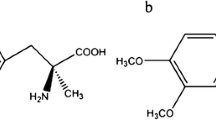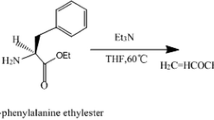Abstract
An enantio-selective d-Phe imprinted P(AA-co-AN) membrane was prepared using the wet-phase inversion method. The membrane not only selectively adsorbed phenylalanine but also rejected it with a rejection selectivity of 0.82–0.64 and 0.91–0.63 during the filtration of 100 and 10 ppm (g m−3) racemate solutions, respectively. The fluxes of d-Phe and l-Phe during filtration of 10 ppm racemate solution were 0.0077–0.0229 and 0.0064–0.0208 mg m−2 s−1, respectively, and the fluxes of d-Phe and l-Phe during filtration of 100 ppm racemate solution were 0.1287–0.2522 and 0.1174–0.2458 mg m−2 s−1, respectively. The adsorption selectivity was higher at low concentration. The adsorption selectivities varied from 1.11 to 1.65 and from 1.64 to 2.78 during filtration of 100 and 10 ppm racemate solutions, respectively. In respect to desorption, the fractional difference between d-Phe and l-Phe in the recovered solution from 10 ppm was higher than that from 100 ppm.






Similar content being viewed by others
Abbreviations
- A :
-
The surface area of membrane (m2)
- C o :
-
Concentration of d- or l-Phe in the feed solution (mg m−3)
- C p :
-
Concentration of d- or l-Phe in permeate (mg m−3)
- C PD :
-
Concentration of d-Phe in the permeate (mg m−3)
- C PL :
-
Concentration l-Phe in the permeate (mg m−3)
- C r :
-
Concentrations of d- or l-Phe in the retentate (mg m−3)
- J Phe :
-
Flux of d- or l-Phe (mg m−2 s−1)
- J W :
-
Flux of solution (m s−1)
- P :
-
Permeability coefficient (m2 s−1)
- P D :
-
Permeability coefficient of the d-Phe (m2 s−1)
- P L :
-
Permeability coefficient of the l-Phe (m2 s−1)
- Q p :
-
Amount of the template adsorbed on the membrane (mg g−1)
- Q D :
-
Amount of the counter enantiomer adsorbed on the membrane (mg g−1)
- R :
-
Rejection of the d- or l-Phe (%)
- R RD :
-
Rejection of d-Phe (%)
- R RL :
-
Rejection of l-Phe (%)
- S DP :
-
Uptake value of the d-Phe (mg)
- S LP :
-
Uptake value of l-Phe (mg)
- T :
-
The required time for a solution to pass through the membrane (s)
- T :
-
Time (in seconds) required water to pass through the membrane (s)
- V O :
-
Volumes of feed solution (m−3)
- V R :
-
Volumes of retentate (m−3)
- V W :
-
Volume of the permeate in (m3)
- α:
-
Adsorption selectivity of the membrane
- α d :
-
Adsorption selectivity of the d-Phe imprinted membrane
- αR :
-
Rejection selectivity of the membrane
- α PS :
-
Permselectivity of the d-Phe imprinted membrane
- ∂:
-
Thickness of membrane (m)
References
Wulff G, Sarhan A (1972) Use of polymers with enzymes-analogues structures for the resolution of racemates. Angew Chem Int Ed 11:341–344
Ul-Haq N, Park JK (2008) Optical resolution of phenylalanine using D-Phe-imprinted poly(acrylic acid-co-acrylonitrile) membrane—racemate solution concentration effect. Polym Compos 29:1006–1013
Ul-Haq N, Khan T, Park JK (2008) Enantioseparation with D-Phe- and L-Phe-imprinted PAN-based membranes by ultrafiltration. J Chem Technol Biotechnol 83:524–533
Piletsky SA, Panasyuk TL, Piletskaya EV, Nichollsb IA, Ulbricht M (1999) Receptor and transport properties of imprinted polymer membranes. J Membr Sci 157:263–278
Yoshikawa M, Izumi J, Kitao T, Koya S, Sakamoto S (1995) Molecularly imprinted polymeric membranes for optical resolution. J Membr Sci 108:171–175
Whitcombe MJ, Rodriguez ME, Villar P, Vulfson EN (1995) A new method for the introduction of recognition site functionality into polymers prepared by molecular imprinting: synthesis and characterization of polymeric receptors for cholesterol. J Am Chem Soc 117:7105–7111
Spivak DA, Shea KJ (1998) Binding of nucleotide bases by imprinted polymers. Macromolecules 31:2160–2165
Piletsky SA, Andersson HS, Nicholls IA (1999) Combined hydrophobic and electrostatic interaction-based recognition in molecularly imprinted polymers. Macromolecules 32:633–636
Matsui J, Nicholls IA, Takeuchi T, Mosbach K, Karubea I (1996) Metal ion mediated recognition in molecularly imprinted polymers. Anal Chim Acta 335:71–77
Zhang Y, Tong A, Li L (2004) Synthesis of molecularly imprinted polymer with 7-chloroethyl-theophylline-immobilized silica gel as template and its molecular recognition function. Spectroc Acta Pt A-Molec Biomolec Spectr 60:241–244
Yang G, Yin J, Li Z, Liu H, Cai L, Wang D, Chen Y (2004) Chiral separation of nateglinide and its L-enantiomer on a molecularly imprinted polymer-based stationary phase. Chromatographia 59:705–708
Sergeyeva TA, Matuschewski H, Piletsky SA, Bendig J, Schedler U, Ulbricht M (2001) Molecularly imprinted polymer membranes for substance-selective solid-phase extraction from water by surface photo-grafting polymerization. J Chromatogr A 907:89–99
Roper DK, Lightfoot EN (1995) Separation of biomolecules using adsorptive membranes. J Chromatogr A 702:3–26
Kobayashi T, Fukaya T, Abe M, Fujii N (2004) Phase inversion molecular imprinting by using template copolymers for high substrate recognition. Langmuir 18:2866–2872
Ulbricht M (2004) Membrane separations using molecularly imprinted polymers. J Chromatogr B 804:113–125
Takeda K, Kobayashi T (2006) Hybrid molecularly imprinted membranes for targeted bisphenol derivatives. J Membr Sci 275:61–69
Porter MC (1990) Hand book of industrial membrane technology. In: Porter MC (ed) Noyes Publications, Westwood
De Bruin TJM, Marcelis ATM, Zuilhof H, Rodenburg LM, Niederländer HAG, Koudijs A, Overdevest PEM, Padt AVD, Sudhölter EJR (2000) Separation of amino acid enantiomers by micelle-enhanced ultrafiltration. Chirality 12:627–636
Li Y, Shahbazi A, Kadzere CT (2006) Separation of cells and proteins from fermentation broth using ultrafiltration. J Food Eng 75:574–580
Jiang Z, Yu Y, Wu H (2006) Preparation of CS/GPTMS hybrid molecularly imprinted membrane for efficient chiral resolution of phenylalanine isomers. J Membr Sci 280:876–882
Wang HY, Kobayashi T, Fujii N (1996) Molecular imprint membranes prepared by the phase inversion precipitation technique. Langmuir 12:4850–4856
Amiri MC, Samiei M (2007) Enhancing permeate flux in a RO plant by controlling membrane fouling. Desalination 207:361–369
Baker RW, Eirich FR (1972) Low Pressure ultrafiltration of sucrose and raffinose solutions with anisotropic membranes. J Phys Chem 76:238–242
Park JK, Chang HN, Park JH, Earmme YY (1986) Direction-dependent flux anomalies in asymmetric reverse-osmosis membranes. Ind Eng Chem Fundam 25:189–195
Gotoh T, Iguchi H, Kikuchi K (2004) Separation of glutathione and its related amino acids by nanofiltration. Biochem Eng J 19:165–170
Park JK, Kim SJ (2004) separation of phenylalanine by ultrafiltration using D-Phe imprinted polyacrylonitrile-poly(acrylic acid)-poly(acryl amide) terpolymer membrane. Korean J Chem Eng 21:994–998
Chen Y, Kele M, Quinones I, Sellegren B, Guichon G (2001) Influence of the pH on the behavior of an imprinted polymeric stationary phase-supporting evidence for a binding site model. J Chromatogr A 927:1–17
Acknowledgment
The authors are indebted to the Center for Advanced Bioseparation Technology for supporting this research.
Author information
Authors and Affiliations
Corresponding author
Rights and permissions
About this article
Cite this article
Ul-Haq, N., Park, J.K. Chiral resolution of phenylalanine by d-Phe imprinted membrane considering rejection property. Bioprocess Biosyst Eng 33, 79–86 (2010). https://doi.org/10.1007/s00449-009-0352-7
Received:
Accepted:
Published:
Issue Date:
DOI: https://doi.org/10.1007/s00449-009-0352-7




